
The London Borough of Hammersmith and Fulham is a London borough in West London and which also forms part of Inner London. The borough was formed in 1965 as the London Borough of Hammersmith from the merger of the former Metropolitan Boroughs of Fulham and Hammersmith. The name was changed to Hammersmith and Fulham in 1979. The borough borders Brent to the north, the Royal Borough of Kensington and Chelsea to the east, Wandsworth to the south, Richmond upon Thames to the south west, and Hounslow and Ealing to the west.

Shepherd's Bush is a suburb of West London, England, within the London Borough of Hammersmith and Fulham 4.9 miles (7.9 km) west of Charing Cross, and identified as a major metropolitan centre in the London Plan.

Sir William Molesworth, 8th Baronet, was a Radical British politician, who served in the coalition cabinet of The Earl of Aberdeen from 1853 until his death in 1855 as First Commissioner of Works and then Secretary of State for the Colonies.

Wood Lane is a street in London. It runs north from Shepherd's Bush, under the Westway (A40) past Wormwood Scrubs where it meets Scrubs Lane. The road is wholly in the London Borough of Hammersmith and Fulham. It is probably best known as the former home of the BBC Television Centre, also BBC White City and formerly BBC Woodlands the offices of BBC Worldwide.
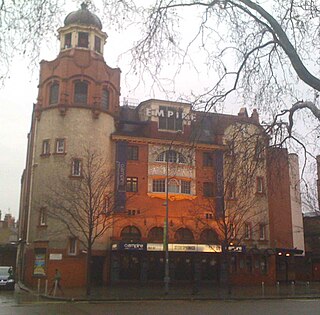
Shepherd's Bush Empire (currently known as O2 Shepherd's Bush Empire for sponsorship reasons, and formerly known as the BBC Television Theatre) is a music venue in Shepherd's Bush, West London, run by the Academy Music Group. It was originally built in 1903 as a music hall for impresario Oswald Stoll, designed by theatre architect Frank Matcham; among its early performers was Charlie Chaplin. In 1953 it became the BBC Television Theatre. Since 1994, it has operated as a music venue. It is a Grade II listed building.

West Kensington, formerly North End, is an area in the ancient parish of Fulham, in the London Borough of Hammersmith and Fulham, England, 3.4 miles (5.5 km) west of Charing Cross. It covers most of the London postal area of W14, including the area around Barons Court tube station, and is defined as the area between Lillie Road and Hammersmith Road to the west, Fulham Palace Road to the south, Hammersmith to the north and West Brompton and Earl's Court to the east. The area is bisected by the major London artery the A4, locally known as the Talgarth Road. Its main local thoroughfare is the North End Road.

John Passmore Edwards was a British journalist, newspaper owner, and philanthropist who briefly served as a Member of Parliament.
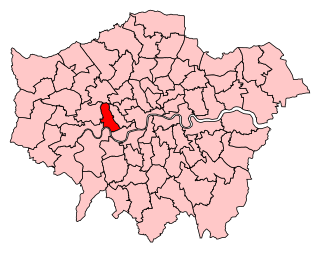
Hammersmith was a parliamentary constituency in the House of Commons of the UK Parliament represented from 2010 until its abolition for the 2024 general election by Andy Slaughter, a member of the Labour Party.

Westfield London is a large shopping centre in White City, west London, England, developed by the Westfield Group at a cost of £1.6bn, on a brownfield site formerly the home of the 1908 Franco-British Exhibition. The site is bounded by the West Cross Route (A3220), the Westway (A40) and Wood Lane (A219). It opened on 30 October 2008 and became the largest covered shopping development in the capital; originally a retail floor area of 1,600,000 sq ft (150,000 m2), further investment and expansion led to it becoming the largest shopping centre in the UK and Europe by March 2018, an area of 2,600,000 sq ft (240,000 m2).

Shepherd's Bush Green is an approximately 8-acre (3.2 ha) triangular area of open grass surrounded by trees and roads with shops in Shepherd's Bush, an area of west London which takes its name from the Green. The Green is also a ward of the London Borough of Hammersmith and Fulham. The population of the ward at the 2011 Census was 12,175.
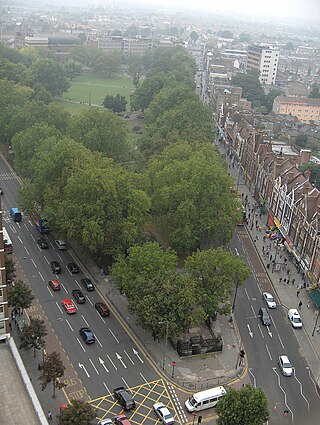
Shepherd's Bush is a neighbourhood in the London Borough of Hammersmith and Fulham centred on Shepherd's Bush Green. Originally a pasture for shepherds on their way to Smithfield market, it was largely developed in the late nineteenth and early twentieth centuries. In 1844 the West London Railway officially opened, followed in 1864 by the Metropolitan Railway who built the original Shepherd's Bush station, opening up the area to residential development. Businesses soon followed, and in 1903 the west side of Shepherd's Bush Green became the home of the Shepherd's Bush Empire, a music hall whose early performers included Charlie Chaplin.

The Shepherd's Bush Pavilion is a Grade II listed building, currently a hotel, formerly a cinema and bingo hall, in Shepherd's Bush, London. Built in 1923 as a cinema, it was badly damaged by a flying bomb in 1944. In 1955, it was restored and re-opened, but it changed ownership a number of times, and eventually in 1983 became a bingo hall. The Pavilion closed its doors for good in 2001, and remained empty and disused for much of the next decade. In 2009, planning permission was granted for conversion into a luxury hotel. Demolition work began in 2012, with only a part of the building's façade retained. The re-built hotel, the Dorsett Shepherd's Bush, London, opened in 2014.

The Shepherd's Bush Palladium was an historic building in Shepherd's Bush, London, originally built in 1910 as the Shepherd's Bush Cinematograph Theatre. The building had a number of owners over the years and finally stopped showing films in 1981. After standing empty for some time, it was eventually converted into a pub and for many years was owned and operated by the Walkabout chain of Australasian-themed bars. In October 2013 the building was sold to a property developer and in 2019 it was largely demolished, replaced in 2021 with a 16-storey block of flats, retaining the original 1920s facade.

The Shepherd's Bush Conservation Area is a part of Shepherd's Bush, London, that has been established by the London Borough of Hammersmith and Fulham in order to promote the protection of local buildings of historic interest, and improve the character of the neighbourhood.
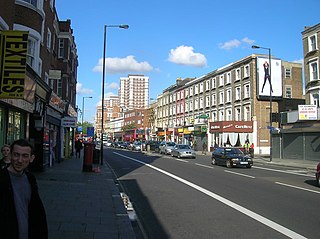
Goldhawk Road is a road in west London, which starts at Shepherd's Bush and travels west. There are numerous shops, restaurants and businesses lining the road, which forms the southern boundary of Shepherd's Bush Green. It is designated part of the A402 road.
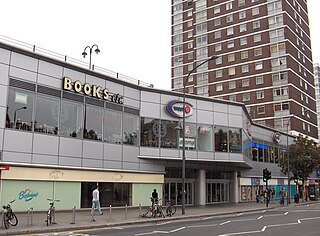
W12 is a shopping centre in Shepherd's Bush in the London Borough of Hammersmith and Fulham that is open from 06:00-23:30 daily and includes shops like Lidl, One Below and Poundland. The modern development borders the south side of Shepherd's Bush Green and was designed in the 1960s.

Hammersmith Park, known to many locals as "The BBC Park" is a public park in the London Borough of Hammersmith and Fulham. It includes a Japanese Garden, a gated children's play area, tennis courts and football pitches run by Play Football. Despite its name, it is located in Shepherd's Bush, not Hammersmith.

Wormholt Park is a 7.75 acres (3.14 ha) urban park in the London Borough of Hammersmith and Fulham, near White City, Shepherd's Bush.

Maurice Bingham Adams FRIBA (1849–1933) was a British architect in the Arts and Crafts style.

The Church of St Simon is a Church of England parish church in Shepherd's Bush, London. It was built circa 1879 - 1886, designed by architect Sir Arthur Blomfield in the Gothic Revival style with a tower. The church is located on the south side of Shepherd's Bush Green on Rockley Road.





















